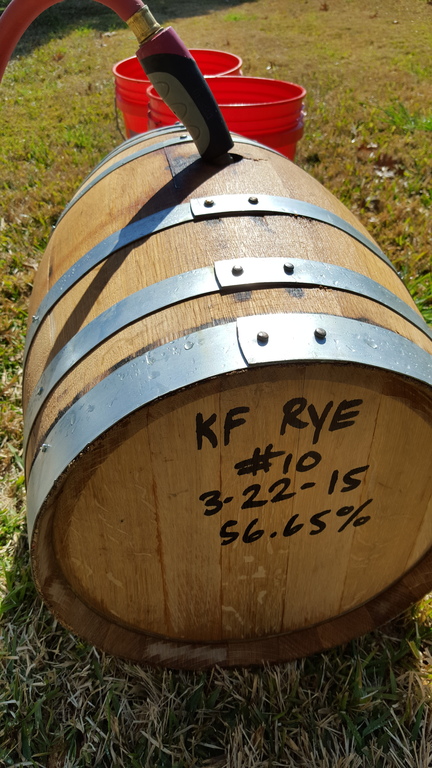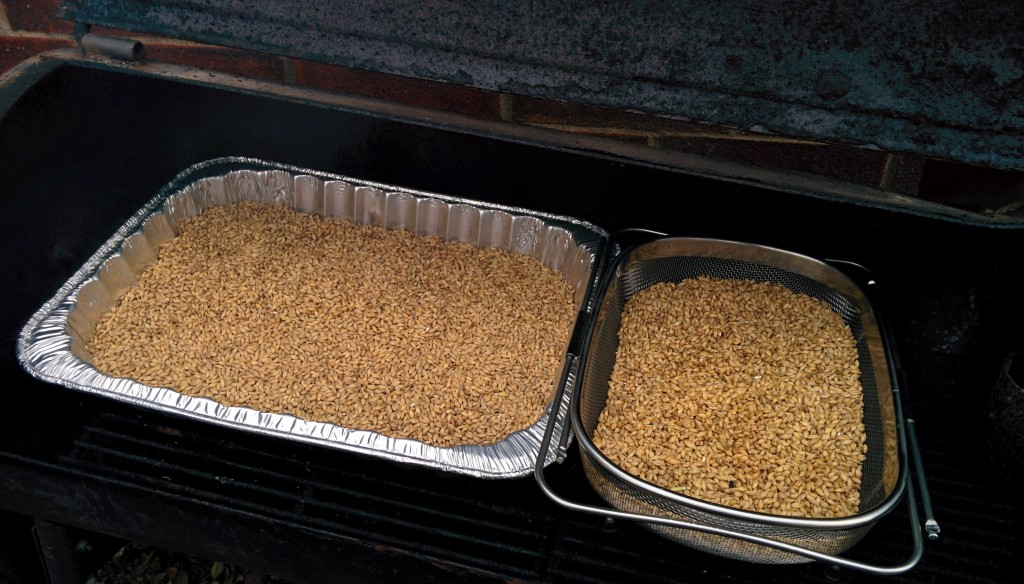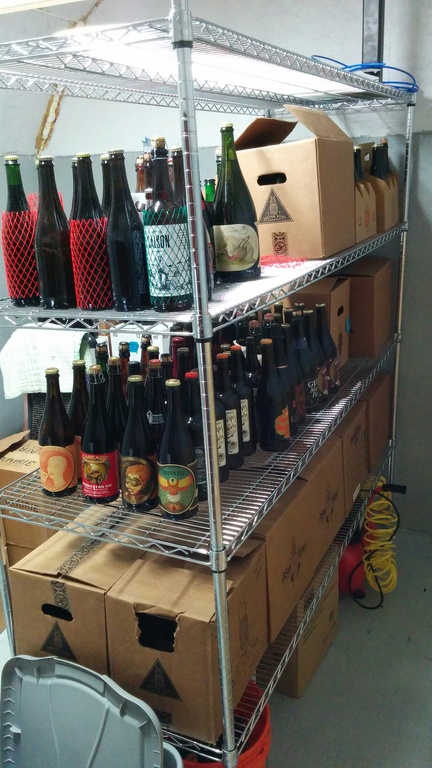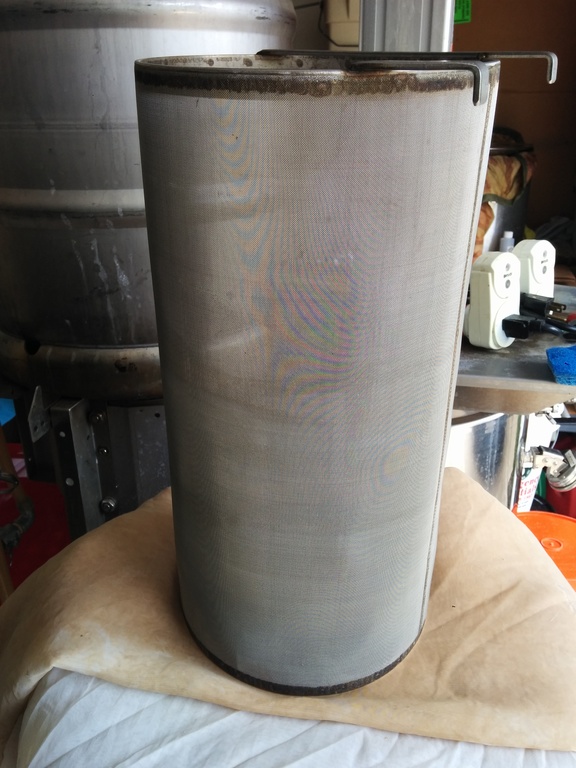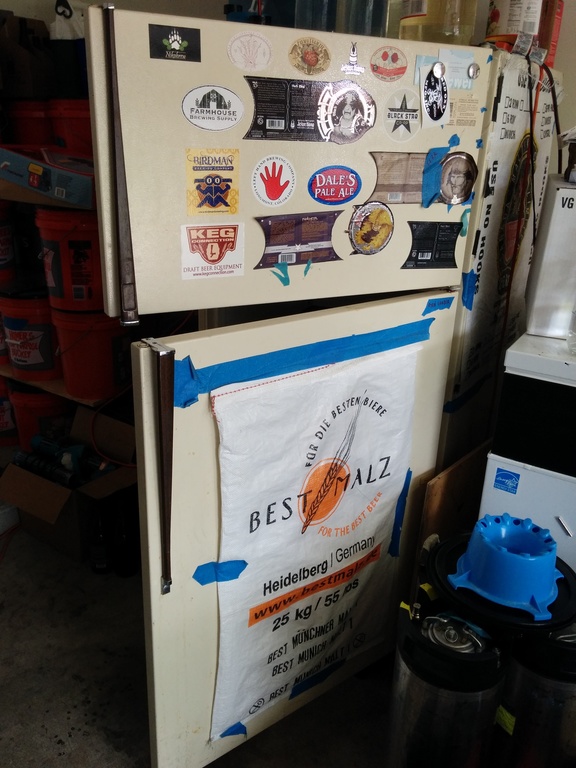
Active fermentation with ECY 20 – Bug Country, 12 hours after pitching. Ambient shed temperature at 55F.
Another year and another Woxbic! This year I was quite a bit late. Normally I’m brewing this batch during January or early February since there aren’t that many days which have cool enough weather for fermentation in the garage in the mid 50s. But better that than not at all. Also with the “magic” of science, I happen to have a shed in which I can keep things at just the right temp, ~55F.
I’m really excited about these lambic-style beers and the fact that the previous two batches are tasting really well! My favorite local brewery, Jester King has just blended their first batch of lambic-style spontaneously fermented beer. I’m about a year away from being able to blend and bottle as well. When brewing for blends, one needs to have enough younger beer to spread out the older beer. So this year, I finally was able to get two barrels.

11 Gallon Rum barrel, waxed with paraffin. 15 gallon Rye Whiskey barrel waits a few weeks for its’ fill.
This brewday I filled the first barrel, another 11 gallon rum barrel. I’ve picked up an additional barrel, 15 gallon Rye Whiskey. After a quick batch of smoked saison, I’ll pick up this recipe and put 15 gallons of Woxbic in it as well.
Recipe-wise, no real changes. I was unable to pickup local Pilsner from Blacklands Malt due to their success. They only offer their pilsner malt under contract; and all available bags are being picked up by other local breweries. I was able to procure some Weyerman Bohemian Pilsner malt from a local brewery Adelberts, so a big thanks to them.
Enjoy!
Recipe Details
| Batch Size | Boil Time | IBU | SRM | Est. OG | Est. FG | ABV |
|---|---|---|---|---|---|---|
| 13 gal | 90 min | 8.7 IBUs | 3.5 SRM | 1.054 | 1.013 | 5.4 % |
| Actuals | 1.046 | 1.01 | 4.7 % | |||
Style Details
| Name | Cat. | OG Range | FG Range | IBU | SRM | Carb | ABV |
|---|---|---|---|---|---|---|---|
| Straight (Unblended) Lambic | 17 D | 1.04 - 1.054 | 1.001 - 1.01 | 0 - 10 | 3 - 7 | 1.8 - 2.6 | 5 - 6.5 % |
Fermentables
| Name | Amount | % |
|---|---|---|
| Pilsner (Weyermann) | 16.25 lbs | 60 |
| Wheat, Torrified | 9.75 lbs | 36 |
| Acidulated (Weyermann) | 1.083 lbs | 4 |
Hops
| Name | Amount | Time | Use | Form | Alpha % |
|---|---|---|---|---|---|
| Northern Brewer | 1.62 oz | 60 min | Boil | Leaf | 3.2 |
Miscs
| Name | Amount | Time | Use | Type |
|---|---|---|---|---|
| Phosphoric Acid | 56.60 ml | 60 min | Mash | Water Agent |
| Epsom Salt (MgSO4) | 3.40 g | 60 min | Mash | Water Agent |
| Calcium Chloride | 1.70 g | 60 min | Mash | Water Agent |
| Gypsum (Calcium Sulfate) | 1.70 g | 60 min | Mash | Water Agent |
| Wheat Flour | 3.25 oz | 5 min | Boil | Other |
Yeast
| Name | Lab | Attenuation | Temperature |
|---|---|---|---|
| Bug Country (20) | East Coast Yeast | 70% | 63°F - 75°F |
Mash
| Step | Temperature | Time |
|---|---|---|
| Acid Rest | 93°F | 15 min |
| Protein Rest | 113°F | 15 min |
| Saccharification 1 | 131°F | 15 min |
| Saccharification 2 | 149°F | 15 min |
| Mash Out | 168°F | 10 min |
Notes
| After mash-out, drain all liquid into boil kettle, raise temp to 190, pump back to mash for second rinse through grain bed. Pitching ECY20 Bugcountry in 15G barrel Phosphoric Acid additions during multi-infusion step mashing: Step1: 20.1 ml in 6.7 gallons Step2: 6.2 ml in 2.07 gallons Step3: 9.09 ml in 3.03 gallons Step4: 16.92 ml in 5.64 gallons Total: 52.3 mL in 17.41 gallons ~ pH of 5.4 (5.2 , 5.3, 5.3, 5.4) |
Download
| Download this recipe's BeerXML file |

